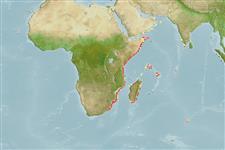Holocephali (chimaeras) (chimaeras) >
Chimaeriformes (Chimaeras) >
Chimaeridae (Shortnose chimaeras or ratfishes)
Etymology: Hydrolagus: hydro-, combining form of hydor (Gr.), water; lagos (Gr.), hare, i.e., “water rabbit,” probably referring to three pairs of tooth plates, which tend to protrude from the mouth like a rabbit’s incisors. (See ETYFish); africanus: -anus (L.), belonging to: Africa, described from deep water off the KwaZulu-Natal South Coast of South Africa. (See ETYFish).
Environment: milieu / climate zone / depth range / distribution range
Ekologi
laut batidemersal; kisaran kedalaman 421 - 750 m (Ref. 3181). Deep-water
Western Indian Ocean: off Kenya, Mozambique and Natal, South Africa.
Size / Weight / umur
Maturity: Lm ? range ? - ? cm
Max length : 67.0 cm TL jantan/; (Ref. 3181)
deskripsi pendek
Kunci identifiaksi (pengenalan) | Morfologi | Morfometrik
Duri punggung (Keseluruhan (total)) : 1; Duri dubur: 0; Sirip dubur lunak: 0. A shortnose chimaera with the dorsal fin spine longer than the head; 2nd dorsal fin with distinct concavity in the middle (Ref. 5578).
Feeds on ophiuroids (Ref. 27637). Oviparous (Ref. 205). Eggs are encased in horny shells (Ref. 205).
Life cycle and mating behavior
Maturities | Reproduksi, perkembang biakan | Spawnings | Egg(s) | Fecundities | Larva
Compagno, L.J.V., 1986. Chimaeridae. p. 144-145. In M.M. Smith and P.C. Heemstra (eds.) Smiths' sea fishes. Springer-Verlag, Berlin. (Ref. 3181)
Status IUCN Red List (Ref. 130435)
penggunaan manusia
Perikanan: tidak ada kepentingan
Alat, peralatan
laporan khas
muat turun XML
Sumber internet
Estimates based on models
Preferred temperature (Ref.
123201): 8.9 - 11.4, mean 9.7 °C (based on 16 cells).
Phylogenetic diversity index (Ref.
82804): PD
50 = 0.5000 [Uniqueness, from 0.5 = low to 2.0 = high].
Bayesian length-weight: a=0.00282 (0.00118 - 0.00673), b=3.10 (2.89 - 3.31), in cm total length, based on LWR estimates for this (Sub)family-body shape (Ref.
93245).
Trophic level (Ref.
69278): 4.1 ±0.60 se; based on food items.
Daya lenting (Ref.
120179): Rendah, Waktu penggandaan populasi minimum 4.5 - 14 tahun (Assuming Fec <100).
Fishing Vulnerability (Ref.
59153): Moderate to high vulnerability (47 of 100).
